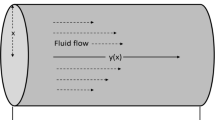Abstract
An analysis has been performed to study the problem of Electrohydrodynamic flow of a fluid in an ion-drag configuration in a circular cylindrical conduit. The governing equations for this problem are reduced to a nonlinear second-order differential equation. The Galerkin Method, Collocation Method and fourth-order Runge–Kutta numerical method are used to solve this problem. Also, Velocity fields have been computed and shown graphically for various values of physical parameters. The objective of the present work is to investigate the effect of the strength of nonlinearity (α) and the Hartman electric number (Ha) on the velocity field. As an important outcome, Increasing Reynolds numbers leads to reduce velocity and excluded backflow in convergent channel.



Similar content being viewed by others
References
Mckee S, Watson R, Cuminato JA, Chen MS (1997) Calculation of electrohydrodynamic flow in a circular cylindrical conduit. J Appl Math Mech 77(6):457–465
Paullet JE (1999) On the solutions of electrohydrodynamic flow in a circular cylindrical conduit. J Appl Math Mech 79(5):357–360
Mastroberardino A (2011) Homotopy analysis method applied to electro-hydrodynamic flow. Commun Nonlinear Sci Numer Simul 16(7):2730–2736
Mosayebdorcheh S (2013) Taylor series solution of the electrohydrodynamic flow equation. J Mech Eng Technol 1(2):40–45
Hasankhani Gavabari R, Janbaz A, Ganji DD (2014) Approximate explicit solution of Orr-Sommerfeld equations and heat transfer in a geometry with variable cross section by He’s methods and comparison with the ADM and DTM, Afr Matematika
Joneidi AA, Ganji DD, Babaelahi M (2009) Differential transformation method to determine fin efficiency of convective straight fins with temperature dependent thermal conductivity. Int Comm Heat Mass Transf 36:757–762
Bor-Lih Kuo, Cheng-Ying Lo (2009) Application of the differential transformation method to the solution of a damped system with high nonlinearity. Nonlinear Anal 70:1732–1737
Abdel-Halim Hassan IH (2002) On solving some eigenvalue-problems by using a differential transformation. Appl Math Comput 127:1–22
Pandey RK, Baranwal VK, Singh CS, Singh OP (2012) Semi-analytic algorithms for the electrohydrodynamic flow equation. J Theor Appl Phys 6:45
Marinca V, Herisanu N, Nemes I (2008) Optimal homotopy asymptotic method with application to thin film flow. Central Eur J Phys 6(3):648–653
Marinca V, Herisanu N (2008) An optimal homotopy asymptotic method for solving nonlinear equation arising in heat transfer. Int Comm Heat Mass Transf 35:710–715
Liao S (2010) An optimal homotopy-analysis approach for strongly nonlinear differential equation. Comm Nonlinear Sci Numer Simulat 15:2003–2016
Ghasemi SE, Hatami M, Mehdizadeh Ahangar GHR, Ganji DD (2014) Electrohydrodynamic flow analysis in a circular cylindrical conduit using least square method. J Electrostatic 72:47–52
Ozisk MN (1993) Heat conduction, 2nd edn. Wiley, USA
Shaoqin G, Huoyuan D (2008) Negative form least-squares methods for the incompressible magneto-hydrodynamic equations. Acta Math Sci 28(3):675–684
Hatami M, Ganji DD (2014) Thermal and flow analysis of microchannel heat sink (MCHS) cooled by Cu-water nanofluid using porous media approach and least square method. Energy Convers Manage 78:347–358
Stern RH, Rasmussen H (1996) Left ventricular ejection: model solution by collocation an approximate analytical method. Comput Biol Med 26:255–261
Hendi FA, Albugami AM (2010) Numerical solution for Fredholm-Volterra integral equation of the second kind by using collocation and Galerkin methods. J King Saud Univ 22:37–40
Sheikholeslami M, Hatami M, Ganji DD (2013) Analytical investigation of MHD nanofluid in a semi-porous channel. Powder Technol 246:327–336
Hatami M, Hatami J, Ganji DD (2014) Computer simulation of MHD blood conveying gold nanoparticles as a third grade non-Newtonian nanofluid in a hollow porous vessel. Comput Methods Progr Biomed 113:632–641
Hu HY, Li ZC (2006) Collocation methods for Poisson’s equation. Comput Method Appl Mech Eng 195:4139–4160
Hatami M, Hasanpour A, Ganji DD (2013) Heat transfer study through porous fins (Si3N4 and AL) with temperature-dependent heat generation. Energy Convers Manage 74:9–16
Herrera I, Diazviera M, Yates R (2004) Single collocation point methods for the advection-diffusion equation. Adv Water Resour 27:311–322
Hatami M, Sheikholeslami M, Ganji DD (2014) Nanofluid flow and heat transfer in an asymmetric porous channel with expanding or contracting wall. J Mol Liq 195:230–239
Vaferi B, Salimi V, Dehghan Bararnia D, Jahanmiri A, Khedri S (2012) Prediction of transient pressure response in the problem reservoirs using orthogonal collocation. J Petrol Sci Eng doi:10.1016/j.petrol.2012.04.023
Aziz A (2009) A similarity solution for laminar thermal boundary layer over a flat plate with a convective surface boundary condition. Commun Nonlinear Sci Numer Simul 14:1064–1068
Author information
Authors and Affiliations
Corresponding author
Additional information
Technical Editor: Francisco Ricardo Cunha.
Rights and permissions
About this article
Cite this article
Hasankhani Gavabari, R., Abbasi, M., Ganji, D.D. et al. Application of Galerkin and Collocation method to the electrohydrodynamic flow analysis in a circular cylindrical conduit. J Braz. Soc. Mech. Sci. Eng. 38, 2327–2332 (2016). https://doi.org/10.1007/s40430-014-0283-3
Received:
Accepted:
Published:
Issue Date:
DOI: https://doi.org/10.1007/s40430-014-0283-3



